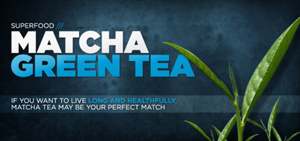 |
|
| Table of Contents: | |
| Nutrition Tips | |
| Drink Matcha Green Tea! | |

If you're not drinking matcha green tea yet, then read this article to learn more about this metabolism-enhancing, stress-reducing, immune boosting, cholesterol-lowering and energy-boosting cancer fighter! Although powdered green tea was developed in China over a thousand years ago, it was the Japanese monks who first cultivated powdered green tea, which they named Matcha1. If you're not drinking matcha green tea yet, then read this article to learn more about this metabolism-enhancing, stress-reducing, immune boosting, cholesterol-lowering and energy-boosting cancer fighter! Although powdered green tea was developed in China over a thousand years ago, it was the Japanese monks who first cultivated powdered green tea, which they named Matcha1. The monks drank it to remain alert and calm during long hours of meditation2. The leaves are grown in Japan in the shade prior to harvesting. This increases their chlorophyll content, allowing absorption of dim light. These chlorophyll-rich leaves are then handpicked, steamed, dried and ground into fine green powder3. So why does drinking 1 cup of matcha green tea provide you with the same amount of antioxidants found in 10 cups of regular green tea? Answer: the entire leaf is dissolved in water and consumed, rather than steeping the tea and subsequently throwing away the leaves3. This means the whole leaf is consumed, along with its health benefits. |
|
| The Health Benefits of Matcha Green Tea | |
| One of the areas in the world where people live the longest is Okinawa, Japan. The Okinawan people's longevity has been partly attributed to regular consumption of matcha green tea1. Matcha green tea is the most popular green tea in Japan, but is rapidly gaining more popularity throughout the world because of its ability to combat inflammation, oxidation and aging.
Matcha green tea possesses:
|
|
| 1. Cancer Prevention: | |
|
Green tea contains potent antioxidants called catechins, which scavenge for dangerous free radicals throughout the body. The most powerful catechin found in green tea is EGCG (epigallocatechin gallate), which is believed to be a powerful anti-carcinogen4. A 2003 University of Colorado study confirmed that drinking 1 cup of matcha green tea has 137 times the amount of antioxidant EGCG compared to a conventional cup of green tea1. |
|
| 2. Heart Disease Prevention: Lowers LDL "bad" Cholesterol | |
| A 2011 study featured in the American Journal of Clinical Nutrition demonstrated that administration of green tea beverages or extracts significantly lowered serum total cholesterol and LDL "bad" cholesterol concentrations.5 | |
| 3. Weight Loss: | |
|
Did you know that drinking matcha green tea could prevent body fat accumulation and promote weight loss? A 1999 study featured in the American Journal of Clinical Nutrition demonstrated that green tea extract rich in catechins has thermogenic properties and promotes fat oxidation beyond that explained by the tea's caffeine content. It was found that consuming green tea increased thermogenesis (the body's rate of burning calories) from 8-10% to 35-43% of daily energy expenditure6. Another study demonstrated that exercising immediately after drinking matcha green tea resulted in 25% more fat burning during exercise4. Both studies suggest matcha green tea can enhance both resting metabolic rate and fat burning, making it a useful addition to any weight loss program. |
|
| 4. Detoxifier: | |
| Matcha is grown in the shade, which is why it is richer in chlorophyll than other green teas. Chlorophyll is the pigment responsible for giving leaves their green color. Chlorophyll is purported to detoxify the body1, but this has yet to be scientifically proven. Nevertheless, I wanted to mention it because of its purported ability to clear the body of toxins, heavy metals, poisons, dioxins and hormone disrupters. | |
| 5. Improves mental alertness, Relieves Stress, Enhances Mood, Evokes Relaxation: | |
|
Matcha green tea contains up to 5 times more L-theanine than conventional green tea2. L-theanine is an amino acid with psychoactive properties, capable of inducing alpha wave activity in the brain. Stress is known to induce the brains' beta wave activity, leading to a more agitated state. Alpha wave activity; however, can relieve stress, promote relaxation and even lower blood pressure1. Although matcha contains some caffeine, the relaxing properties of L-theanine counterbalance the "jittery" effects of caffeine. Therefore, a cup of matcha green tea promotes concentration and clarity of mind without producing any of the nervous energy typically associated with coffee.2 Ancient Japanese monks used matcha green tea as an aid to their meditation rituals because of its ability to promote calmness and sustain their focus and energy for up to 8 hours at a time1. Be sure to try a cup of matcha green tea as an afternoon "pick-me-up" anytime you need extra focus. |
|
| 6. High in Fiber: | |
|
Matcha green tea contains a high level of easily absorbable dietary fiber. When you drink matcha green tea, you consume the entire tealeaf that contains vitamins, minerals and fiber that would have otherwise been thrown away with a conventional green tea bag1. The benefits of dietary fiber include its ability to ease constipation and stabilize blood sugar levels. |
|
| 7. Energy Boost – Ideal Substitute for Coffee: | |
|
When people withdraw from the caffeine in coffee, they typically suffer from fatigue and headaches. Matcha green tea is an ideal substitute for coffee because it provides an energy boost without the "coffee jitters", allowing you to quit your coffee habit without experiencing headaches1. Caffeine in coffee spikes your adrenaline and cortisol levels, causing an "energy crash" afterwards. Unlike coffee, matcha contains much less caffeine and has a calming and relaxing effect, which is why it has been used by Japanese monks for over a thousand years to enhance meditation, relaxation, focus and concentration1. |
|
|
Where to Purchase Matcha green tea is available as a concentrated powder and can be found at health food stores. Organic matcha is recommended because it is produced without any artificial fertilizers, herbicides or pesticides. |
|
|
Preparation Tips Do not add the matcha green tea powder to boiling water because it will taste "grassy"7. Boil the water and let it sit for 5 minutes before adding it. It is an acquired taste. |
|
|
Summary of Health Benefits2
|
|
References:
|
|
|
|
|
| What is Quinoa and How do you Cook it? | |

Quinoa (pronounced keen-wah), is a whole grain known for being a dietary staple of the ancient Incas of South America. It is a low-glycemic index complex carbohydrate, as well as an excellent source of protein, providing all 9 essential amino acids. This gluten-free high-fiber ancient grain is most typically available in stores in the red or golden varieties. Quinoa has a slightly nutty flavor and a light fluffy texture. Red quinoa has a chewier texture and a stronger and more earthy flavor than its golden counterpart. Both provide a source of vitamin E, B vitamins, calcium and phosphorus. After removing it from the package, place the quinoa into a sieve (fine strainer) and rinse it in ample running water for several minutes to remove its bitter-tasting coating of unpalatable saponins. Note that most commercially sold quinoa has had this bitter coating already removed, so it can be used without pre-rinsing. |
|
| There are 2 ways to cook quinoa: | |
|
|
| Always measure the quinoa AFTER it has been cooked. Store left-over cooked quinoa in the fridge for 4 days. If you accidentally cook more than 4 days worth of quinoa, you can freeze it for later use. Store unused uncooked quinoa in the freezer. | |
| Did you Know? | |
|
Tomatoes are a rich source of lycopene, a powerful anti-cancer agent. But did you know that lycopene needs fat to be optimally absorbed? Be sure to add a healthy fat to your tomato dishes, such as olive oil. |
|
| Don't Crucify Cruciferous Vegetables! | |
| Be sure to read Sara's newest article for bodybuilding.com, "Power Plants: Feast On These Vitamin-Dense, Cancer-Fighting Veggies" by clicking here. | |
|
|
|
| Health Tips: | |
| Is it safe to have amalgam dental fillings? | |
|
As a pure element, mercury is poisonous and we are all exposed to mercury in air, water, soil and food. The mercury in a dental amalgam; however, is chemically BOUND in a stable ALLOY of silver, copper and tin. That being said, amalgam fillings still do release minute amounts of mercury vapor with chewing. This mercury vapor can be absorbed by the body (where it accumulates mostly in the kidneys) and can even cross the placenta. But this is also true of mercury absorbed from food such as tuna. Keep in mind that mercury's toxicity is related to the amount that is actually absorbed. Health Canada estimates that the average Canadian adult aged 20-59, absorbs 9 millionths of a gram per day from all mercury sources1. Of this amount, it is estimated that dental amalgam contributes to 3 millionths of a gram per day1. Amalgam is the most durable and affordable restorative material, and has been used for 150 years. For the majority of people, no harmful effects have been caused by mercury exposure from amalgam fillings1. "Current scientific consensus supports the position that amalgam does not contribute to illness"2. Alternative restorative materials; however, should be considered for the 3% of the population who are sensitive to the components of amalgam3, as well as for patients with neurological conditions, impaired kidney function or those who are immunologically compromised1. Note, dental amalgam itself is not linked to these conditions, but should be avoided to minimize the total body mercury burden with this particular compromised patient population. It should also be avoided with patients with known occupational mercury exposure and those who eat a seafood-only diet1. Health Canada also released the following statement concluding that while "the research evidence did not support excluding children, pregnant or lactating women…from receiving amalgam fillings…common sense dictated that pregnant women should avoid any elective medical or dental intervention until after delivery."1 Health Canada has also taken the position that "new amalgam fillings should not be placed in contact with existing metal devices in the mouth, such as braces"1 because of the risk of a galvanic effect, which is the potential for electric current to be generated when 2 different metals are in close proximity. Recent evidence suggests that galvanic effect may slightly increase the release of mercury vapor from amalgam1. |
|
| Should you have your amalgam fillings replaced? | |
|
If your amalgam restoration and tooth are fully intact and you have no indication of adverse health effects attributable to mercury exposure, then NO, it does not make sense to replace the amalgam filling merely because of questions being raised about possible amalgam toxicity. The risks of mercury vapor release and tooth trauma during the amalgam removal process versus the benefits of improved aesthetics and "peace of mind" is something that you will have to consider after consulting with your dentist. Replacement should be considered for patients who are sensitive to dental amalgam. If your amalgam restoration is wearing down, fractured, or is no longer sealing the tooth (risking or possessing recurrent decay), then the amalgam should be removed and replaced with a new filling or possibly a crown, depending upon the amount of tooth structure remaining. Your dentist will use techniques and equipment to minimize your exposure to mercury vapour during amalgam placement and removal, such as a rubber dam, and high volume evacuation with copious water. Anytime you introduce a foreign substance into your body for therapeutic use, there will be an element of risk. Talk to your dentist and determine if there are special reasons to be cautious about using amalgam in your situation. Inquire about alternative restorative materials such as composite resin, ceramic inlays/onlays or gold castings. Keep in mind that all dental materials have their advantages and disadvantages, and depending upon the size and location of the cavity, some materials will be more suitable than others. Together, you and your dentist can decide which filling material will work best for you. The final decision is always yours. |
|
|
References: |
|
|
|
|
|
|
| Fitness Tips: | |
|
Click on the video link to watch and learn Buddy Lee's "Basic Bounce and Alternate-Foot Step": Dr. Sara Solomon Cross Speed Jump Ropes by Buddy Lee available for only $29.95! Click on the Cross Speed photo to the left to purchase.
|
|
 |
|
| For more health, exercise, nutrition, sleep and attitude tips, be sure to read Sara's Oxygen Magazine Blog, "Work Train Compete!". | |
 |
Read all the blogs: |
| And be sure to read all of Sara's articles featured in the February 2012 issue of FitnessX Magazine (on which she proudly graces the cover!): click on the cover to read more: | |
 |
Don't forget to enter the 30/90 day challenge (for free) for your chance to win $50,000 cash! Put some excitement into reaching your health goals! Click on the photo to the left to enter. |
| For your better health, Dr. Sara Solomon | |


